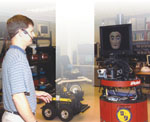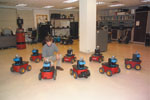Developing Reasoning Robots for Today and Tomorrow
Scientists are working on projects for current deployment and preparing for future needs. 
Navy Center for Applied Research in Artificial Intelligence (NCARAI) researcher William Adams interacts with “George,” a robot personality implemented in an iRobot B21r robot. George can understand natural speech and hand gestures and uses a cognitive model of human behavior to interact more naturally with humans.
Military artificial intelligence programs are making humans, not systems, the focus of their development efforts as they study methods to make tools easier to use. Programs are being focused on using artificial intelligence to free people for the most important tasks and incorporating automation to save lives.
Programs are underway to deliver near- and long-term solutions to the troops, and forecasters expect projects in several fields, including intelligence, to experience an increase in products and funding in the next several years.
At the U.S. Naval Research Laboratory (NRL),
The NCARAI, which has been operating for 25 years, has several sections—including Immersive Simulations, Intelligent Multimodal/Multimedia Systems, Intelligent Systems, and Interface Design and Evaluation—that study different aspects of artificial intelligence.
Schultz explains that in subject areas such as robotics, users almost have to be specialists in robotic equipment to take advantage of the technology. “We’re trying to get more to the view of the warfighter being more of the supervisor,” Schultz states. At the NRL, developers see the robot as an asset to obtain information for the warfighter. For example, an unmanned aerial vehicle (UAV) might require three full-time staff members to operate it. One person might act only as an assistant, because the other two must dedicate their time to operating the aircraft. New systems would be able to manage themselves better if human operators were busy with other assignments. This autonomy also could benefit the warfighter by allowing the system to make adjustments based on conditions in situations where the UAV has better situational awareness than humans.
Robot-human interaction is another significant area of artificial intelligence research at the NRL. Laboratory personnel are examining ways to develop technology in which one human operates one robot or even multiple robots. To achieve that goal, the robots would have to have high levels of capability. The scientists are examining how humans and robots can interact in more natural ways. “We’d rather have the robots accommodate the human than have the humans have to accommodate the robots,” Schultz explains. Creating robots that reason more like humans will make them more compatible with humans.
To reach this stage, staff at the NRL have been studying how humans operate by creating computational cognitive models. By modeling human behavior, developers can create robots that work in ways that are normal for humans. Work is being done to make movements, gestures and speech more natural. Robots also could be made to reason and perform mental simulations using algorithms. The robots would be able to manipulate a simulation in its computer and see the world from another person’s point of view. Schultz says robots now can see from different perspectives.
A related line of research is machine learning. Machines that can learn and adapt are more robust in the field. NRL research is examining how a robot can adjust to continue its mission if it loses a sensor, or if a team of robots loses one member, how the others can redeploy to meet the intended objective. Applications for machine learning include protecting ships and other assets.
Other teams at the NRL are studying artificial intelligence in different fields and applications. Schultz says much of the work conducted at the laboratory relates to military training. NCARAI scientists evaluate training systems that can provide realistic training for troops. They also use immersive simulation to study troops’ movement in a virtual world. The result is a realistic, first-person shooter game with a setting that participants perceive they are actually in. In these games, one group studies how humans respond to stress, heat and other factors, and another group develops novel ways for moving around inside the virtual world.
The NCARAI also has a group interested in lessons learned systems. After the military transfers its lessons learned information to a database, artificial intelligence can help retrieve exactly the right data and apply it to future situations to help troops avoid the same problems.
 |
| Eight ActivMedia Pioneer robots are available for homogeneous robot teaming applications. These units are currently used to verify an evolutionary computation approach to group protection of a resource from multiple aggressors. |
The NCARAI team that is examining means to visualize high-dimensional data looks at ways to make that data understandable. Some possible methods could be a three-dimensional graph, but Schultz says the team also is determining methods to produce a four-dimensional graph. He explains that sound might be one way, and the group is examining whether audio clues could help people understand the high-dimensional data better.
Artificial intelligence also could help warfighters with information overload. Decision makers often have too much information to make use of, and some troops wear headphones that deliver different information to each ear. The service members have to make sense of what they hear. A team at the NCARAI is finding ways to separate the information to help listeners understand it better.
With the advent and proliferation of network-centric warfare, unmanned platforms, sensors and other tools are feeding more data back to the military than humans can look at and make sense of. Schultz states that one of the problems facing the military is how to make the most of all this data.
Bradley J. Curran, an industry analyst with Frost and Sullivan, sees a current artificial intelligence trend in bringing information from different sources—infrared electro-optic from multiple platform angles, integrated with maps, signals intelligence emitters and human intelligence data—together and quickly passing the information to troops on patrol. However, he does not believe that artificial intelligence is a primary way to enhance network centricity. Instead, humans could access information through analysis tools that are artificial intelligence-based to help an analyst find correlations and relationships in large amounts of data. Artificial intelligence can handle routine functions, while analysts focus on high-priority or difficult tasks. “Artificial intelligence is still sort of like a spell checker,” Curran explains. “It catches a lot of stuff, but it’s still stupid. A knowledgeable person still has to determine what is relevant.”
According to Schultz, as the number of unmanned vehicles in the military continues to climb, the military either must increase in size to fulfill all the manning requirements or make the vehicles easier to use. He explains that developers must not think of warfighters as the operators of the system because “warfighters need to be warfighters.” Artificial intelligence should assist the people. “A lot of work is really about reduced manning,” he shares. “It has to do with reduced manning and giving our guys better situational awareness.”
Curran asserts that another major trend in artificial intelligence is unmanned vehicles of all types—air, land and sea—that can determine their own routes and avoid collisions. He expects unmanned vehicle brains to be the biggest artificial intelligence breakthrough in the near future. These brains will allow vehicles to negotiate obstacles and will recommend alternative routes/procedures to their operators. Unmanned vehicles have many benefits for troops. By obtaining better information from unmanned aerial vehicles, warfighters can stay out of harm’s way. Robots that detect and neutralize improvised explosive devices can save lives. Robots also could control sniper fire and locate the source of fire. He states that artificial intelligence will free people to perform the most pressing and vital tasks, while machines will carry out the work that is dull, dirty and dangerous.
Schultz echoes Curran, stating, “It’s not hard to imagine all the ways unmanned vehicles can help.” To provide the assistance, however, the vehicles must be easy to use. “We need these vehicles to have enough smarts not to burden the soldier with them,” Schultz shares. “They’ve got to be easier to control, more like the soldier being a supervisor than a robot operator.”
Curran says that shortages in personnel are driving military artificial intelligence technology to help fill in the gaps. “They need tools to help make up the shortages of linguists and troops to patrol remote areas and inner cities,” he explains. In the next five to 10 years he expects that artificial intelligence will remain well funded and that applications will increase. With the growing need for human intelligence, he predicts advances in analyst tools to digest the technical information collected and an emphasis on greater precision in technical intelligence platforms.
A current major artificial intelligence project across the military and in the private sector is translation devices, which are in demand for troops in
Even with all advances in artificial intelligence, humans always will have to make the important judgment calls, according to Schultz. When a robot makes decisions, it is conditioned on the rules of engagement and other factors. No robot will release a weapon without a human taking responsibility for it.
Web Resources
Frost and Sullivan: www.frost.com


